Huawei’s suite of residential products has broadened with new arrivals in the first half of 2019. In the scramble to find more rooftop spaces to be retrofitted with solar PV, system designers have been met with the challenge of partial shading and otherwise arguably unsuitable rooftops.
Huawei’s Smart PV Optimizer SUN2000-375W-P2, in combination with the company’s new Smart Energy Center Sun2000-3-10KTL-M1 (3-10 kW) and SUN-12-20KTL-M2 (12-20 kW), promise to address the issue. The new residential products allow module level power electronics to be fitted only to the individual solar panels that are subjected to unfavorable orientation or partial shading.
Instead of fitting 20 or more PV optimizers to offset shading challenges, it would now be possible to fit them, for example, only to the four modules that are affected by the nearby tree or chimney. This further reduces the cost of the system, increasing PV’s competitive edge in many markets.
The optimizers use DC cabling for communication with the inverter and other associated power electronics, which improves the security of the communication standard against wireless solutions, and eases installation when compared to designated communication cabling solutions.
The new inverters weigh about 17 kg for the 3-10 kW option and 25 kg for the 12-20 kW inverter. Thanks to this high energy density, outperforming that of many competitors, Huawei says that its inverter can be installed by one person alone. Setting aside the lower weight of the inverter, the company also touts that its new generation of inverters also has an improved cabling interface. The new interface allows installation of cables without the removal of the inverter cover, which is required for most other inverters. This not only helps to further reduce installation costs, but also improves the ingress protection, avoiding installers fiddling with the factory condition of the equipment.
Leveraging its expertise in telecommunications technology, Huawei has fitted its new inverters with 4G dongles, ensuring stable Internet connection from the inverter to the energy management system. This could be particularly helpful in carport installations or projects where the inverter is installed out of reach from a homes’ Wi-Fi connection.
The inverter is battery-ready, requiring no additional power electronics or new cabling should the owner decide to retrofit a battery storage system. With feed-in tariff regimes fading out in many markets, the question of self-consumption or finding alternative revenue streams for prosumers has come into new focus. Most new use cases, such as integrating PV systems into virtual power plants or operating home appliances to improve self-consumption, require the flexibility that is provided by a storage system. While still prohibitively expensive in many markets, battery systems will become of greater interest for many system owners within the lifetime of their installation, making an easy retrofit an important feature in a hard-fought inverter marketplace.
This content is protected by copyright and may not be reused. If you want to cooperate with us and would like to reuse some of our content, please contact: editors@pv-magazine.com.
